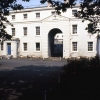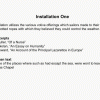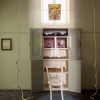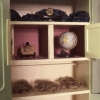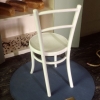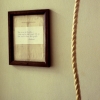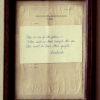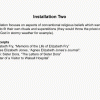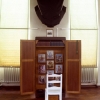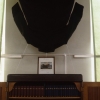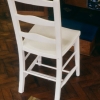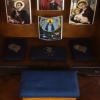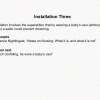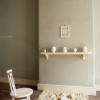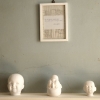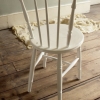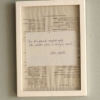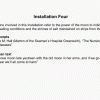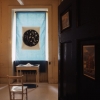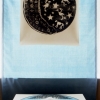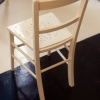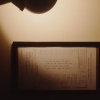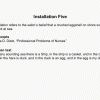Summer Lightning
Installations at the Dreadnaught Seaman’s Hospital, Greenwich
The Dreadnaught was founded “in the 17th century to provide a home for naval pensioners, the building became a hospital in 1870. It ceased to be a hospital in 1986 and the building is now empty. It is a challenging setting, but…an impressive demonstration of how effective such site specific commissions can be.
This is partly due to the work of Elizabeth Bryant, who has ranged six separate installations throughout the building. Their continuity of motif… the careful research they demonstrate and their apposite use of the spaces chosen, give coherences to slightly unnerving wander through empty wards and silent corridors which viewing the show entails.“ 1
“Elizabeth Bryant stages a metaphorical encounter of two figures, sailor and nurse. In each room, this nurse is figured by a plain chair painted white (signifier of hygiene and Christian notions of purity) and by a voice as it emanates from audio tapes on which are heard her report on the patient’s condition, excerpts from training manuals and medical texts of the period, and so on. The seaman is represented through six distinct shrines, featuring zodiac calendars, broken eggshells, pieces of fabric, nautical objects and other charms. Gender, class, profession, belief, and compartment mark radically different configurations of identity. These differences are conveyed in their relation to complex codes of language: science and superstition, religion and charms, professional vigil and ritualistic protections.” 2
“Soundtracks trace the development of nursing from the dedicated efforts of charitable ladies to an organized profession. The ‘Memoirs of the life of Elizabeth Fry’ (1841) describe an exhausting daily routine…The 1935 ‘professional Problems of Nurses’ exhorts nurses to keep abreast of current affairs’…The 1964 ‘Manual of simple Nursing Procedures’ restricts itself to informed medical guidance.” 3
“Other, handwritten, texts tell about the patients. From them we learn that sailors are superstitious, they used to carry babies’ cauls in the pouches to protect from harm. Paintings of ships, casts of babies’ heads, garlic in nets, broken eggshells are set before us as we listen to the words of nurses describing those wanderers whose spells had failed, whom illness rendered subject to control, returned to the hands of women.” 4
1. Lynn MacRitchie, “Installation Art: Summer Lightning,” Financial Times, London, August 6, 1992. 2. Renee Baert, “Summer Lightning,” Art Press International, Paris, August 1992. 3. Sarah Kent, “From Bed to Nurse,” Time Out, London, June 1992 4. Lynn MacRitchie, “Installation Art: Summer Lightning,” Financial Times, London, August 6, 1992.

